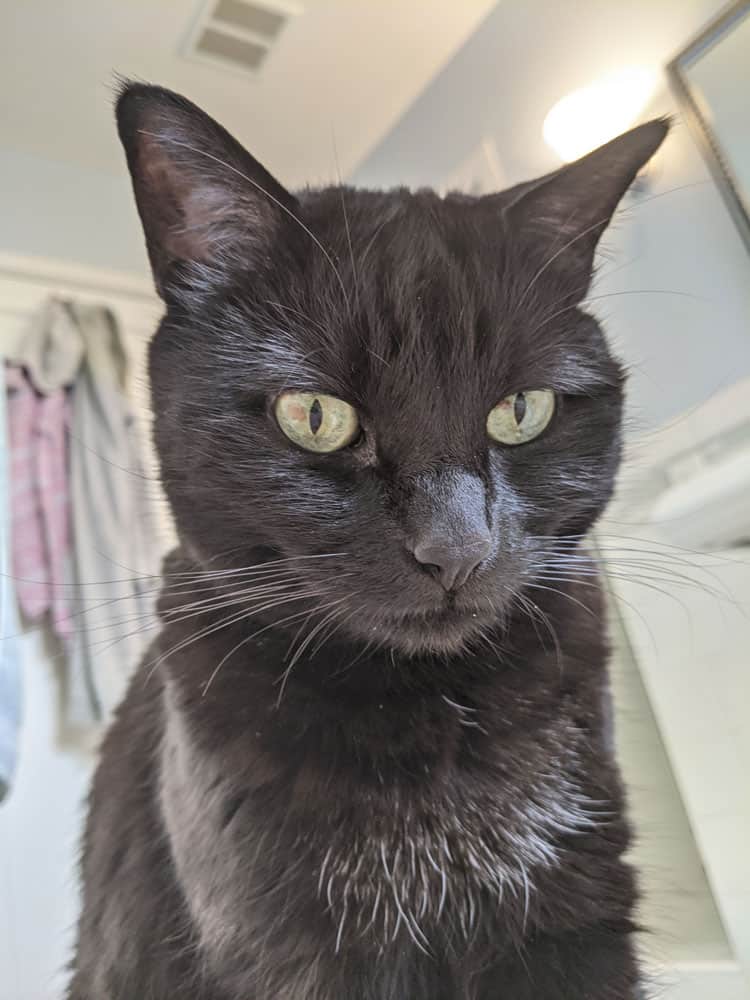A fear of cats has several different names. The most commonly accepted term for being severely afraid of cats is ailurophobia. The term stems from the Greek words αἴλουρος (ailouros), for cat ‘cat’ and φόβος (phóbos) for ‘fear’.
Other names for a strong fear of cats are: felinophobia, elurophobia, gatophobia, and cat phobia. Ailurophobia is the medical definition for a fear of cats.
Ailurophobia is an anxiety disorder
Ailurophobia is not a mild fear or dislike of cats. People with ailurophobia experience severe reactions to the presence of cats, even if seen remotely on a screen or a photography. Exposure to cats can cause someone with ailurophobia to experience excessive sweating, trembling, racing heart, dryness of mouth, and other markers of a panic attack.
The diagnosis of ailurophobia, like other specific phobias, is typically made based on clinical interviews and assessments by mental health professionals. The criteria for diagnosis often include a persistent and excessive fear that is immediate upon exposure to cats, leading to avoidance or intense distress. This phobia can significantly impact a person’s daily life, especially if their environment makes avoiding cats challenging. A person whose is severely afraid of cats is known as an ailurophobe.
Who coined the term ailurophobia?
The term ailurophobia is credited to Silas Weir Mitchell, an American Physician who published an article published on May 27, 1905 in American Medicine entitled, “Of Ailurophobia and the Power to be Conscious of the Cat as Near, When Unseen and Unheard.”
In this article, S.W. Mitchell describes, with anecdotes, cat terrors so intensely felt by people that they can sense cats even when they can’t see them. Mitchell recounts a story of his father having placed a cat inside a closet with the door close. Afterwards, an acquaintance with a deep-seated fear of cats came into the room to look at some books. Mitchell recounts, “He sat down, but in a few minutes grew pale, shivered, and said, ‘There is a cat in the room.’ Dr. M said, ‘Look about you. There is no cat in the room. Do you hear one outside?’ He said, ‘No, but there is a cat.’ He became faint, and complaining out nausea, went out, and recovered.”
How common is ailurophobia?
The exact prevalence of ailurophobia among humans has not been measured but according to the Irena Milosevic, a professor Psychiatry & Behavioural Neurosciences at McMaster University , a fear of cats is not as common as some other animal fears such as a fear of spiders or bats.
How does ailurophobia develop?
Psychiatrists have several theories on how a person can develop a fear of cats. One common cause is a traumatic experience with cats during childhood, such as being scratched or bitten. The fear might also arise from observing others who are afraid of cats, a process known as vicarious learning. Additionally, some psychological theories suggest that certain phobias may be partly influenced by genetics or evolutionary factors. Psychological predispositions, such as a higher general tendency towards anxiety, can also play a role in the development of ailurophobia.
Treatments for a fear of cats
For individuals with a medical diagnosis of ailurophobia, treatment needs to be done under the supervision of a medical professional. Since this phobia is not a mild fear of cats and can have an adverse affect on the person’s mental and potentially physical health, a medical professional would need to come up with a treatment plan that the patient would need to proceed with under the supervision of a psychiatrist or other qualified medical provider.
Treatments for a fear of cats, or ailurophobia, typically involve psychological therapies. Cognitive-behavioral therapy (CBT) is one of the most effective methods, focusing on changing the thought patterns and behaviors associated with the fear. Exposure therapy, a form of CBT, gradually introduces the individual to cats in a controlled environment, helping them to desensitize to their fear. In some cases, medication might be prescribed to manage symptoms of anxiety and panic. Relaxation techniques and support groups can also be beneficial in coping with and overcoming this phobia.
References
Gul, S. (2022). Ailurophobia-Irrational Fear of Cats with Possible Treatment spotlights to a prevailing disorder: 11-HJPV4 (1)-2022 Short Communication. Hamdard Journal of Pharmacy, 2(2), 1-3. DOI: https://doi.org/10.61744/hjp.v2i2.28
London, L. S. (1952). Ailurophobia and ornithophobia. Psychiatric Quarterly.
Milosevic, I. (2015). Ailurophobia. (Fear of Cats). In I. Milosevic & R.E. McCabe (Eds.), Phobias: The Psychology of Irrational Fear (pp 11-12). ABC-CLIO.
This article was originally written on October 12, 2021 and has since been updated.







